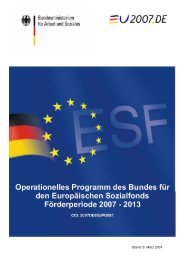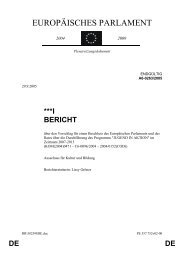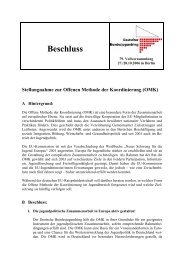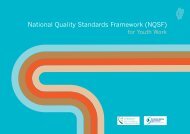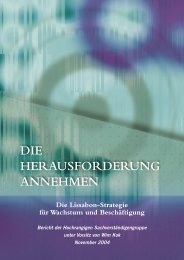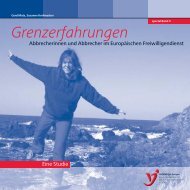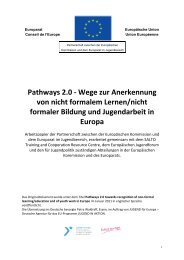Report - Salto
Report - Salto
Report - Salto
Create successful ePaper yourself
Turn your PDF publications into a flip-book with our unique Google optimized e-Paper software.
52<br />
Bridges for Recognition | Good Practice workshops - Overview and highlights<br />
Some fears were expressed in the discussions in the workshops: The question “Where is the<br />
fun?” summed up the concern that recognition was a step towards formalising the non-formal<br />
sector. It seemed that in many of the examples given there was a balance to be achieved between<br />
participation in a process of evidence gathering and self reflection and the demand or desire for<br />
a recognisable outcome – the certificate to prove you were competent.<br />
The instruments described in the workshops were many and varied; from paper based to<br />
electronic; from self-assessed and peer assessed to assessment by a “jury” of youth workers. It<br />
was interesting to see examples of recognition processes being adapted for different sectors and<br />
in different countries – for example from arts and culture to international youth work and from<br />
Finland to Slovenia.<br />
An example of using a self perception inventory was given (in relation to recognition of youth<br />
trainers), as a tool to establish base lines at the start of the learning experience. This would<br />
enable learners to measure how far they had travelled during the experience. Other approaches<br />
highlighted the need for multiple points of entry and the freedom to keep trying if the required<br />
standard was not achieved at the first assessment. Some had no formal assessment but focussed<br />
on collecting and presenting evidence in a way which highlighted the skills, knowledge and<br />
attitudes of the individual; others had extensive lists of competencies arranged at different<br />
“levels”, from which learners can choose the ones they wish to demonstrate.<br />
As a communication tool at European level, a common language is needed for jargon and<br />
terminology (see p.38). Some examples were given of certificates or equivalents being available<br />
in more than one official language. Together these things will promote transferability from<br />
sector to sector and country to country.<br />
Another challenge, particularly in relation to meeting standards, is the question of who is<br />
competent to say that one person meets the required standard and another is not. Who should sit<br />
on the “jury” if there is one and are we allowed to say that one person is not a good youth worker<br />
– particularly across national and cultural boundaries?



